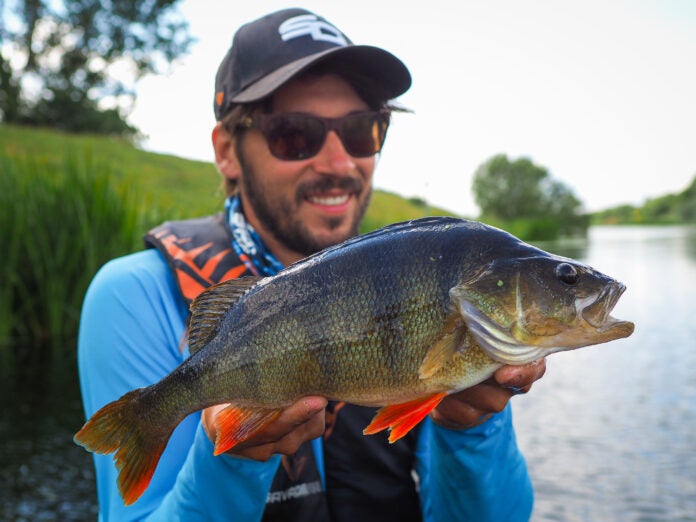Topwater Perch
After exploring new venues on my road trip, and now back home, the urge to explore was still with me. Thinking about what to do next, I was a bit lost. I received a message from Rob and Sam, who were planning on travelling to Lincolnshire, asking me if I would like to join them, and just like that I was off. The plan, to target perch on some of the rivers and drains. Venues I had never fished before, and an opportunity to try new styles.
We all met in the local pub for dinner and drinks, accompanied by Ash Costa. Ash has managed to fine-tune perch fishing in his region, turning it into somewhat of an art form. His captures and consistency speak for themselves. Naturally, I was keen to pick his brains and learn some of his techniques, to add to my own perch fishing armoury. It quickly became apparent that Ash’s local perch fishing was unlike anything I’d experienced in the UK.
Duckweed is a huge problem here, clogging up entire sections of river and drain, leaving it seeming unfishable. This was not the case! Where many would dismiss fishing, Ash had been refining American-style topwater and punching techniques, adapting them to catch big perch from some very unlikely places. We all talked for hours, sharing our fisherman’s tales and forming new friendships, until it was time to leave. Sleep was hard that night, like a kid at Christmas I lay awake, eager to unwrap the secrets held in these waters at first light.
Dawn arrived and we set off in search of perch. Sam, Rob, Ryan and I began by searching different areas. The fishing, uneventful with only a few small perch banked. Finally, we arrived at a likely spot with signs of silver fish dimpling the surface. Soon the first feeding flurry of the day began, with the twins banking some quality pound-plus perch on topwater lures. Eventually, Rob and Ryan had to depart, leaving Sam and I to fish out the day. Instead of spot fishing we decided to inflate my E-Rider kayak, and take to the water in search of some untouched gems.
The drain was crystal-clear, with duckweed covering miles of the waterway. Bright sunlight would make it difficult to find fish in the open, but with so much cover finding them at all would be a challenge. Fishing through the weed would also be difficult. Heavy Texas and Carolina rigs to punch through the dense matting would be the option, topwater lures fished in the thick of it may grab a bonus fish too. I’d left my weedless frog box at home, not expecting to encounter such a situation, luckily Sam had bought some Pop Shadz, a weedless lure that can be fished weightless. Perfect for this scenario.
We paddled down to a thinner area of weed and began working the water. We fished opposites to find a winning tactic. I punched through with a Texas rig while Sam fished the top. It didn’t take long until a bow wave appeared behind Sam’s lure, followed by a gulp! He was in. The fish fought hard in dense weed, it was well hooked and soon hit the net. A lovely mid-two. We continued on exploring spots and alternating tactics, catching on all methods, but we couldn’t locate anything big.
Fairly strong rods work best with weedless lures as they need a bit of resistance to set the hook. I was using my 3-16g Fast Shad which is soft enough to resist small pulls, but quickly becomes strong enough to put the power down. Although you strike some bites on topwater, most of the time you just continue working the lure until the fish hooks itself. You get lots of false bites and short strikes while fishing for perch, but very often they will keep hitting it until hooked.
After miles of paddling in the heat, through duckweed, thick and viscous like porridge, we arrived at a good area. A smaller drain entered, and the duckweed was sunbaked and thick. Clear water surrounded the feature, making it one of the few safe areas for a predator to hide. I cast my lure into the dense weed and began popping it back.
Suddenly! Bow waves and strikes appeared everywhere, lashing at the lures. There were too many perch competing, we had found the jackpot. Sam and I cast again. With the fish aware this time it wasn’t long until I got a take. I struck into a quality fish and while playing it Sam did the same. A double hook-up of two pounders. We gave the spot a rest and photographed the fish, returning for Round Two.
Once again, we hooked up to numerous good fish fighting hard beneath the weed, seemingly trying to avoid the bright daylight. We continued the process, banking eight 2s and numerous 1s, before calling it a day. It was probably the best topwater perching I’ve ever experienced. I’m not sure how I can translate this to the Broads. But it certainly showed me that unorthodox methods can work in unlikely places.
















